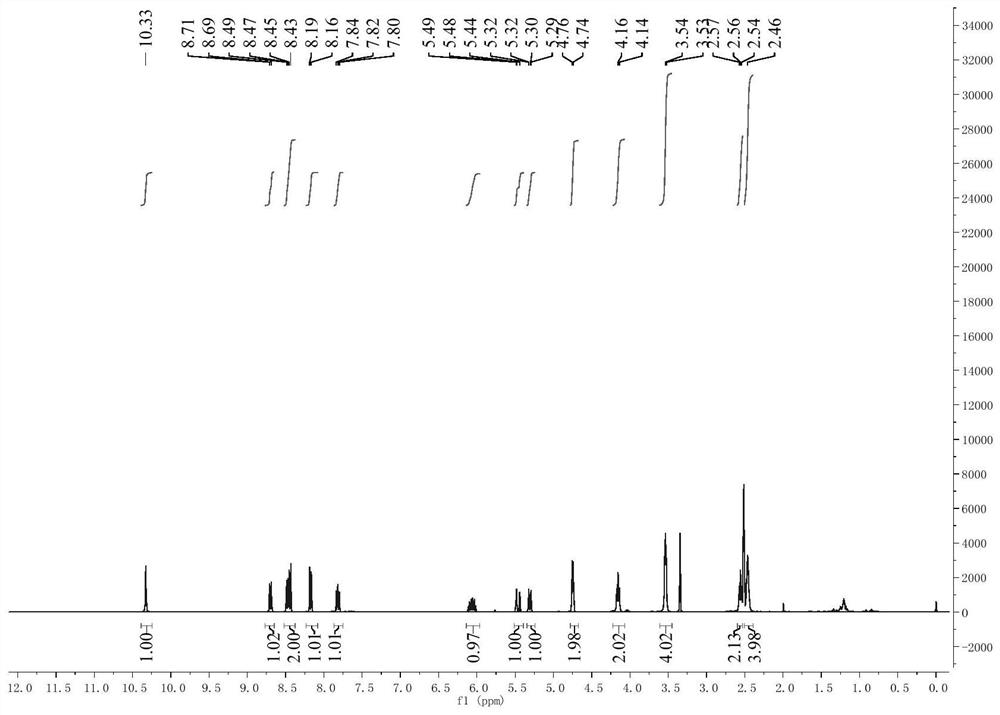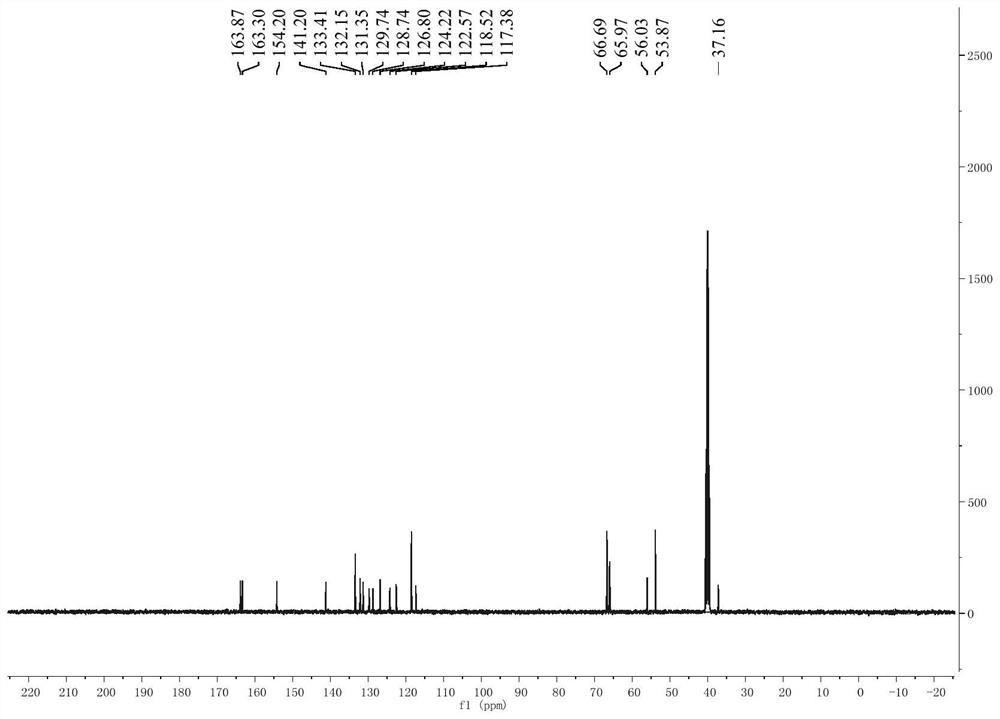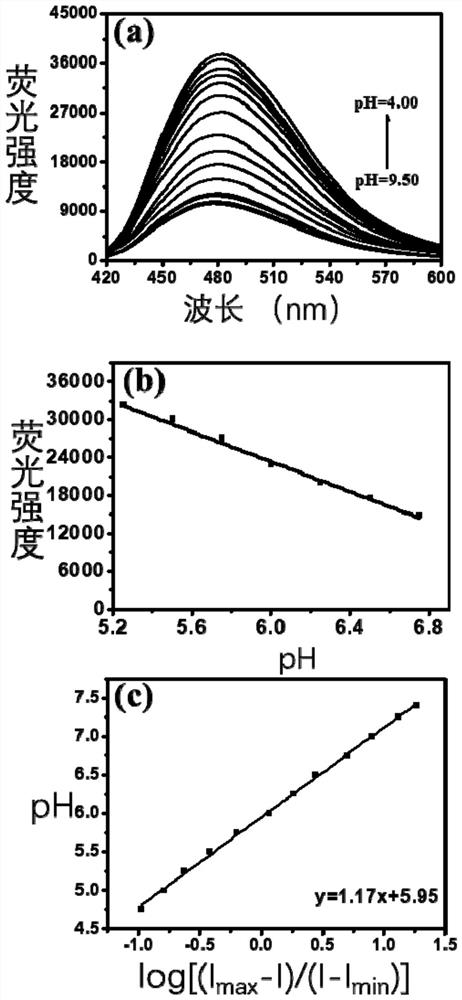A kind of bifunctional fluorescent probe for detecting pd concentration and pH value and its preparation and application
A fluorescent probe and dual-function technology, applied in the field of fluorescent probe detection, can solve problems such as environmental pollution and human health, and achieve the effects of high selectivity and simple preparation method.
- Summary
- Abstract
- Description
- Claims
- Application Information
AI Technical Summary
Problems solved by technology
Method used
Image
Examples
Embodiment 1
[0052] Embodiment 1: the preparation of probe (I)
[0053]
[0054] Compound II, dichloromethane and triethylamine were added to a 25 mL round bottom flask, followed by allyl chloroformate, and stirred overnight at room temperature. The ratio of compound II, triethylamine and allyl chloroformate is 1:2.5:2.5, wherein the compound II is 0.3mmol, and the amount of dichloromethane is 5mL. Stir the reaction at 25°C for 10h, evaporate under reduced pressure Dry solvent, the crude product was separated and purified by column chromatography, the eluent was dichloromethane / methanol=30:1, v / v, and 55 mg of yellow probe (I) was obtained with a yield of 43.7%. For its H NMR spectrum, see figure 1 , C NMR see figure 2 .
[0055] 1 H NMR (400MHz, DMSO-d 6 )δ (ppm) 10.33 (s, 1H), 8.70 (d, J = 8.5Hz, 1H), 8.46 (dd, J = 13.5, 7.7Hz, 2H), 8.17 (d, J = 8.3Hz, 1H), 7.87–7.75(m,1H),6.07(ddt,J=16.0,10.7,5.5Hz,1H),5.46(dd,J=17.2,1.6Hz,1H),5.35–5.24(m,1H),4.75( d, J=5.5Hz, 2H), 4.16(t, J=...
Embodiment 2
[0056] Example 2: Fluorescence spectrum test of probe (I) (5 μM) response to pH.
[0057] Accurately weigh a certain amount of probe (I) (prepared in Example 1), prepare a probe mother solution with a concentration of 0.05mM with dimethyl sulfoxide, pipette 50 μL into 0.45mL PBS buffer, and configure into DMSO / PBS buffer (1:9, v:v, pH is 4.00, 4.50, 4.75, 5.00, 5.25, 5.50, 5.75, 6.00, 6.25, 6.50, 6.75, 7.00, 7.25, 7.40, 8.00, 8.50, 9.00, 9.50), make the probe final concentration 5 μ M, add in the 96-well plate after shaking up, measure the change situation of the fluorescent spectrum of probe (I) with multifunctional microplate reader, and make correlation linear curve.
[0058] Depend on image 3 In (a), it can be seen that as the pH decreases, the fluorescence intensity of the probe (I) is continuously enhanced, and the fluorescence intensity at 485nm and the pH value also show a good linear relationship in the range of 5.25-6.75 (linear regression equation: F =-11835*[pH]...
Embodiment 3
[0059] Embodiment 3: the selectivity research of probe (I) to pH
[0060] Accurately weigh a certain amount of probe (I) (prepared in Example 1), prepare a probe mother solution with a concentration of 1 mM with dimethyl sulfoxide, pipette 50 μL and add it to 0.45 mL containing different metal ions (in order of PBS, Cu + 、Cd 2+ 、Co 2+ 、Cu 2+ , Mn 2+ 、Sr 2+ 、Ba 2+ , Fe 2+ , Zn 2+ , Ca 2+ 、Al 3+ , Pd(PPh 3 ) 4 ) in PBS buffer (pH 4.50 or 7.40), configure DMSO / PBS buffer (1:9, v:v, pH 7.40), make the final concentration of probe 5μM, metal ion final concentration 10μM, shake well Then add it to a 96-well plate and measure the change of the fluorescence spectrum of the probe (I) with a multifunctional microplate reader.
[0061] Fluorescence spectrum see Figure 4 . The data show that several important metal ions have little effect on the fluorescence signal of the probe (I) under the PBS buffer environment with pH 4.50 or 7.40. The above experimental data show tha...
PUM
 Login to View More
Login to View More Abstract
Description
Claims
Application Information
 Login to View More
Login to View More - R&D
- Intellectual Property
- Life Sciences
- Materials
- Tech Scout
- Unparalleled Data Quality
- Higher Quality Content
- 60% Fewer Hallucinations
Browse by: Latest US Patents, China's latest patents, Technical Efficacy Thesaurus, Application Domain, Technology Topic, Popular Technical Reports.
© 2025 PatSnap. All rights reserved.Legal|Privacy policy|Modern Slavery Act Transparency Statement|Sitemap|About US| Contact US: help@patsnap.com



